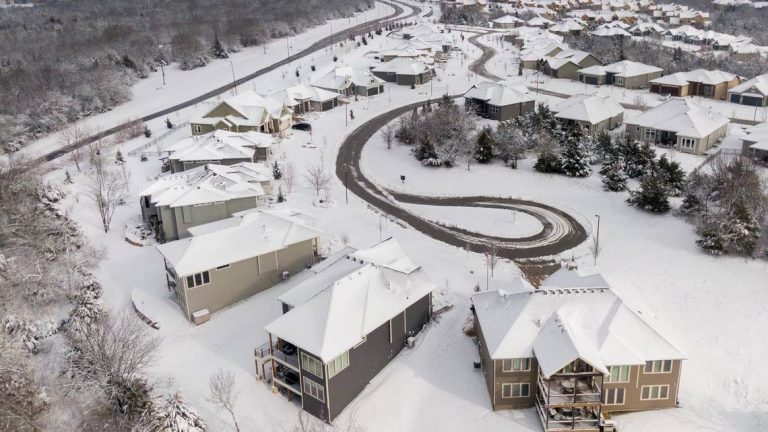A winter storm dumped several inches of snow in the Kansas City area, including west Lenexa where subdivisions were covered in snow on Tuesday.
tljungblad@kcstar.com
When you look up at your home during cold winter weather, you probably notice icicles hanging from the gutters and edges of the roof.
[–>
But a more hazardous formation may be hiding just above these icicles — and it has the potential to cause damage to your home.
[–>
An “ice dam” is a ridge of ice at the bottom of a slanted roof that prevents water from draining into gutters or dripping off the roof’s edge. It’s formed when snow on a rooftop begins to melt, but freezes into a solid mass before it can drain away, the University of Minnesota Extension explains.
[–>
By itself, an ice dam won’t destroy your home. The hazard appears when more melted snow builds up behind the ridge, creating a pool of water.
[–>
Most roofs aren’t designed to withstand stagnant pools of water for long periods of time — instead, this water can leak into the roof, damaging the ceiling and walls of your home. If left untreated, this seeping water can cause mildew, damage your insulation or even impact the structural integrity of your home.
[–>
Here’s what to know about this wintertime formation, and what to do if your roof develops one.
[–>
Why do ice dams form?
[–>
The primary factor behind ice dam formation is varying roof temperatures. Snow will melt on the parts of a roof that are above freezing, but re-freeze into ice wherever the temperature drops below freezing.
[–>
The most common reason for different parts of your roof to be different temperatures is poor insulation. Warm air from indoors may be increasing the temperature of your roof while the section at the bottom edge is still cold. This can cause an ice dam to form and lead water to pool up behind it.
[–>

How do I prevent an ice dam from forming?
[–>
One way to ensure ice dams don’t form on your home is to check the attic or ceiling insulation on your top floor. No heat should be able to escape to warm the roof above it. Proper insulation can also lower your heating bill by preventing energy waste.
[–>
Another important measure is to clean out your gutters before winter weather arrives. A gutter clogged with wet leaves or other debris prevents melting snow from draining away, and can quickly lead to an ice dam.
[–>
If it’s possible to do so safely, it’s also a good idea to remove snow from your roof after each big snowfall — especially if temperatures are forecasted to fluctuate above and below freezing, according to the home improvement site Family Handyman. You can do this using a snow roof rake or by calling in snow removal professionals.
[–>
How do I get rid of an ice dam?
[–>
If you suspect you have an ice dam on your roof, don’t panic — the ridge of ice alone is unlikely to cause any damage to your home.
[–>
If you can do so safely, use a snow roof rake or other tool to carve channels in the ice dam so water can flow off your roof rather than pooling up. Pouring warm water onto the ridge can also help melt it quickly, although you should never step out onto a snowy roof to do this (or any other project).
[–>
If you find water leaking inside your home due to an ice dam, it’s time to call in professional help. Left untreated, water leaking into your home can cause mold and other health and safety problems. Luckily, many homeowners’ insurance policies cover damage caused by ice dams.
[–>
Do you have more questions about extreme weather in the Kansas City area? Ask the Service Journalism team at kcq@kcstar.com.
[–>


